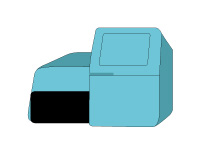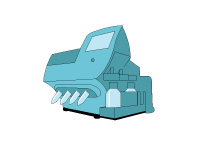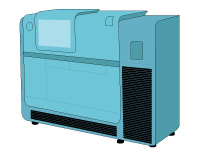NGS Grade Oligos Perform Higher than Alternatives
Minimize Index Hopping Levels
These NGS Oligos dramatically out performed alternate vendors for a fraction of the cost, based on a comparable study of cross contamination. The table and the image below provide the range of index hopping reported by other suppliers of NGS grade oligos.
Use NGS Grade adapters, capture probes, and fusion primers from Eurofins Genomics to increase the chance of success in any Next Generation Sequencing (NGS) experiment. With the cost of typical NGS projects in thousands of dollars, you need oligos that deliver results consistently.
| |
Range (%) |
Lowest Reported |
| Eurofins Genomics |
0.06–0.02* |
0.006* |
| Alternate Providers |
2.0–0.25 |
|
| Typical Values in literature |
10–0.01 |
|
*the typical range and lowest index hopping results reported here are based on data provided by our customers.
Index adaptors from Eurofins Genomics have higher full-length oligonucleotide content (i.e., purity) and lower cross contamination with co-synthesized oligonucleotides (crosstalk), consequently, leading to a reduction in index hopping during demultiplexing. While typical cross contamination observed with our NGS Grade processing is 0.06-0.02%, our partners have reported index hopping levels of 0.006% for HPSF-purified oligos.
How to Order
This option is selected from the purification dropdown menu on the oligo order pages. Detailed directions are on the second tab of this page.
Platform Compatibility
 |
 |
 |
| Illumina HiSeq™, MiSeq®, and NextSeq™ |
Ion Torrent™ |
PacBio™ RS II |
NGS Grade Oligos are prepared using carefully optimized synthesis and post-synthesis protocols to ensure that crosstalk between co-synthesized oligos is reduced to a minimum. These adaptors are suitable for any NGS grade application across different platforms - Illumina, PacBio, 454, and Ion Torrent.
Uses and Applications
Oligonucleotides processed using the NGS Grade services are suitable for several library preparation protocols within the NGS workflow. These include, but are not limited to,
- Ligating barcoded adapters to samples for multiplexing
- Generation of amplicon libraries using Fusion PCR method
- Target enrichment using capture probes
- Use as blockers to prevent barcode participation in hybridization experiments
Order these oligos using the custom oligos and tubes and plate order editors. If you would like to evaluate these oligos in your application and provide feedback, please reach out to us at GenomicsSupport@eurofins.com with the details of your project and requirements.
How to Order
You can select the NGS oligo option from most, normal order pages by clicking it the purification dropdown list. Additional details are below.
- Go to the order page
- On the second step, click the Purifications dropdown menu
- Select NGS Grade-Salt Free option.
- Add the order to your cart and checkout.
Where to Order
- Available on the Custom Oligos tube and plate order page
- Available on the EXTREmer tube and plate order pages.
- Available in single tubes or 96-well plates.
- Selected from the purification dropdown menu.
- Salt Free is available for NGS-Grade Oligos.
- Synthesis scales: 4 nmole to 10 μmole.
- Length: 5 bases long to 200 bases.
- Delivered dry or concentration normalized.
The protocols for generation of Eurofins Genomics' NGS Grade oligos are optimized to minimize the cross contamination during the extraction, purification and transfer steps. The resulting oligos can minimize the contribution from synthesis-related index hopping.
Use NGS Grade adaptors, fusion primers, and capture probes to increase your chance of success in NGS experiments. These salt free NGS grade oligos can be used in any platform, including Illumina, PacBio, Ion torrent, or 454. To request for NGS grade service for HPLC purified oligos please reach out to genomicsus@eurofins.com.
| Option |
NGS Grade-Salt Free |
| Product |
Custom Oligos |
EXTREmers |
| Cross Contamination |
<0.06% |
<0.06% |
| Typical Purity* |
>70%** |
>80%** |
| Delivered in |
Tubes/Plates |
Tubes/Plates |
| Sequence length |
5–125 bases |
60–200 bases |
| Scales |
10, 25, 50, 250, 1000, 2000, 5000, 10000 nmole synthesis scales |
4 nmole yield only |
| Modifications |
Biotin, phosophorothioate, and more |
Biotin, phosphorothioate, and a few more |
| OD/Yield Guarantee |
Same as for Salt free oligos - see here |
4 nmole |
| Quality Control |
Mass Spec |
Mass Spec/FCE |
| Quality Standards |
|
|
Additional processing days (Turnaround Time)
|
3 days |
3 Days |
| Platform Compatibility |
- Illumina HiSeq™,
MiSeq®, and
NextSeq™
- PacBio™ RS II
- Ion Torrent™
|
- Illumina HiSeq™, MiSeq®, and NextSeq™
- PacBio™ RS II
- Ion Torrent™
|
*These are typical CE purity levels observed for test oligos of 40–60-mers
**The purity of salt free oligos is dependent on the length, sequence, and modifications, and therefore, cannot be guaranteed.
What is Index hopping?
Index misassignment1 or hopping, i.e., instances where reads from a given sample are computationally associated or mixed with a different sample or samples in the pool during demultiplexing, is a common phenomenon occurring across all NGS platforms. While low levels of index hopping do not impact routine NGS applications, in some specific cases these can lead to confounding data or, more significantly in specific instances, inaccurate conclusions. Some of these applications include:
- identification of low frequency somatic mutations—these provide important biological insights in the context of cancer
- sequencing DNA from ancient samples or samples—a single copy of the DNA can be taken as evidence for DNA survival or presence of contamination
- profiling gene expression or microbial populations—crosstalk can lead to erroneous conclusions
- detection of infectious disease causing agents—false positives from other samples
Moreover, the high throughput nature of NGS platforms allow for multiplexing of samples. This mulitplexing allows for significant cost reductions and flexibility in experimental design in studies that:
- investigate mutations or single nucleotide polymorphisms (SNPs) by whole genome or targeted exome sequencing
- identify DNA-Protein interactions (ChIP-Seq)
- profile the transcriptome (RNA-Seq), or
- characterize the epigenome.
NGS Grade oligos from Eurofins Genomics
The reported cross contaminations levels appear to vary with the platform2 and library preparation protocols. While double indexing3 and recommended best practices from each NGS platform can partially reduce levels of crosstalk, one platform-agnostic factor for the observed sample crosstalk is the cross contamination of one adaptor with a co-synthesized adaptor during the high-throughput synthesis of oligonucleotides. Eurofins Genomics has partnered with researchers to optimize the post-synthesis handling and processing work-flow to provide oligos that meet the demanding needs of their experiments. The oligos, provided as NGS grade oligos, are suitable for demanding NSG grade applications.
- Barcoded oligonucleotides, produced using NGS Grade service, from Eurofins Genomics significantly reduce index misassignment in next generation sequencing projects.
- Oligonucleotides manufactured under the NGS Grade service protocol reduce crosstalk for standard salt free oligonucleotides.
1Index Mis-assignment is also often referred to by other names, including index hopping, index swapping, index switching, sample contamination, index crosstalk, or demultiplexing noise.
2Sinha, R. et al. (2017) Index Switching Causes "Spreading-Of-Signal" Among Multiplexed Samples in Illumina HiSeq 4000 DNA Sequencing, biorxiv, ttp://www.biorxiv.org/content/early/2017/04/09/125724
3 Kircher, M., Sawyer, S., Meyer, M. (2012) Double indexing overcomes inaccuracies in multiplex sequencing on the illumina platform, NAR, Vol. 40, Issue 1, pages e3.